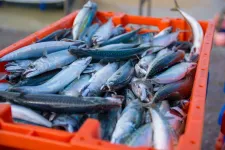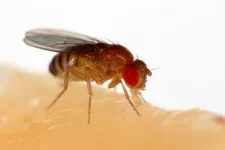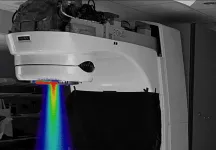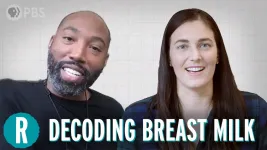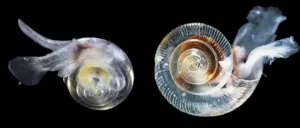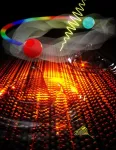(Press-News.org) Consumers of purchased foods have no way of ascertaining the quality and safety of the food that existing distribution systems deliver to their plates. Unfortunately, inappropriate refrigeration can sometimes lead to food spoilage, which is often difficult to detect. Such is the case for mackerel fish, which readily develop harmful levels of a substance called histamine when left at room temperature for too long. Histamine is neurotoxic and can trigger severe allergic reactions, including rashes, vomiting, and diarrhea. Because spoiled fish can sometimes look and smell completely normal, it is important to accurately quantify histamine levels in fish samples to ensure food quality has been properly maintained during transportation and storage.
Although several techniques to detect histamine exist, they generally require expensive and bulky equipment, as well as the presence of a qualified analyst. To address these limitations, a team of scientists at Chung-Ang University, Korea, recently developed a new quantification method that is simultaneously simple, effective, and inexpensive. In their study, which was led by Professor Tae Jung Park and Jong Pil Park and published in Biosensors and Bioelectronics, the team describes their novel approach based on the use of fluorescent carbon nanoparticles and a protein that binds strongly to histamine.
First, the scientists looked for peptides--short chains of amino acids--with the highest affinity and selectivity against histamine. To do this, they employed phage-display technology, in which the external proteins of genetically modified viruses are used to check for chemical interactions. After screening with a large peptide library, they identified the best one for their purposes, called "Hisp3."
Then, the scientists produced fluorescent carbon nanoparticles called "carbon quantum dots (CQDs)" and coated them with N-Acetyl-L-Cysteine (NAC), a naturally occurring compound that also binds to Hisp3. The CQDs are fluorescent, meaning that upon irradiation with ultraviolet light, they re-emit the captured energy at a lower, visible frequency. However, their fluorescence is "quenched" when Hisp3 is added to the mix, which binds to the NAC and covers the CQDs' surface.
This last part is essential to the method because, when a histamine-containing sample is mixed with the CQDs, the Hisp3 unbinds from the NAC and binds to the histamine, restoring the original fluorescence levels of the CQDs in direct proportion to the concentration of histamine (as shown in the accompanying figure). By comparing the initial and final fluorescence levels of the CQDs using a fluorescence detection instrument or a handheld UV-irradiation flashlight, it is possible to indirectly quantify the concentration or intensity of histamine in the sample.
The proposed strategy was validated using fish samples with known histamine concentrations and other established techniques as well. Surprisingly, the new method proved to be more powerful than existing ones despite being simpler, as Prof. Park remarks, "We managed to accurately measure histamine concentrations ranging from 0.1 to 100 parts per million, with a limit of detection as low as 13 parts per billion. This means our approach is not only more convenient but also more effective and sensitive than those currently available methods."
Thus, this new method can not only detect dangerous histamine levels, but can also assess the state and quality of food products, as Prof. Park explains, "While the detection of histamine as a harmful factor is important, our approach can further serve to objectively measure the quality and freshness of food, thereby contributing to increasing food safety and benefitting consumers."
Additionally, the proposed methodology could be applied using other peptides to accurately determine the concentration of different chemicals in food samples and biomedical specimens. If adopted by the food and medical diagnostic industries, this method could provide us with the much-needed assurance that the food we consume and the environmental conditions we live in are safe.
INFORMATION:
Reference
Authors: Rongjia Shi (a), Shuaihui Feng (a), Chan Yeong Park (a), Kyung Yeol Park (a), Jeonghun Song (b), Jong Pil Park (b), Hyang Sook Chun (b), Tae Jung Park (a)
Title of original paper: Fluorescence detection of histamine based on specific binding bioreceptors and carbon quantum dots
Journal: Biosensors and Bioelectronics
DOI: 10.1016/j.bios.2020.112519
Affiliations:
(a) Department of Chemistry, Research Institute of Chem-Bio Diagnostic Technology, Chung-Ang University
(b) Department of Food Science and Biotechnology, School of Food Science and Technology, Chung-Ang University
About Chung-Ang University
Chung-Ang University is a private comprehensive research university located in Seoul, South Korea. It was started as a kindergarten in 1918 and attained university status in 1953. It is fully accredited by the Ministry of Education of Korea. Chung-Ang University conducts research activities under the slogan of "Justice and Truth." Its new vision for completing 100 years is "The Global Creative Leader." Chung-Ang University offers undergraduate, postgraduate, and doctoral programs, which encompass a law school, management program, and medical school; it has 16 undergraduate and graduate schools each. Chung-Ang University's culture and arts programs are considered the best in Korea.
Website: https://neweng.cau.ac.kr/index.do
About Professor Tae Jung Park from Chung-Ang University
Dr. Tae Jung Park is a Distinguished Professor in the Chemistry Department of Chung-Ang University, and his research interests include exploring novel technologies for bio-nano convergence studies, such as biosensors and nanocomplex fabrication. He received bachelor's and master's degrees from the Chungnam National University, Korea, in 1998 and 2000, respectively. He received his doctoral degree from the Department of Chemical & Biomolecular Engineering of KAIST in 2004. He previously served as a research professor and chief researcher at the BioProcess Engineering Research Center in KAIST. He has more than 215 publications to his credit.
Website: http://nbc.cau.ac.kr/
Scientists are searching for lithium technology alternatives in the face of the surging demand for lithium-ion batteries and limited lithium reserves. Russian researchers from Skoltech, D. Mendeleev University, and the Institute of Problems of Chemical Physics of RAS have synthesized and tested new polymer-based cathode materials for lithium dual-ion batteries. The tests showed that the new cathodes withstand up to 25,000 operating cycles and charge in a matter of seconds, thus outperforming lithium-ion batteries. The cathodes can also be used to produce less expensive potassium ...
Having a choice of foods may accelerate aging and shorten the lifespan of fruit flies, according to a study published today in the open-access eLife journal.
While early experiments have shown that calorie restriction can extend lifespan, the current study adds to the growing body of evidence that suggests other diet characteristics besides calories may also influence aging and lead to earlier death.
"It has been recognised for nearly a century that diet modulates aging," says first author Yang Lyu, Postdoctoral Fellow at the Department of Molecular & Integrative Physiology, University of Michigan Medical School, Ann Arbor, US. "For our study, we wanted to see if having a choice of foods affects metabolism and lifespan in the fruit fly Drosophila melanogaster."
Lyu ...
LEBANON, NH - A joint team of researchers from Radiation Oncology at Dartmouth's and Dartmouth-Hitchcock's Norris Cotton Cancer Center (NCCC), Dartmouth Engineering, and Dartmouth-Hitchcock's Department of Surgery have developed a method to convert a standard linear accelerator (LINAC), used for delivery of radiation therapy cancer treatment, to a FLASH ultra-high-dose rate radiation therapy beam. The work, entitled "Electron FLASH Delivery at Treatment Room Isocenter for Efficient Reversible Conversion of a Clinical LINAC," is newly published online in the International Journal of Radiation Oncology, Biology & Physics.
The exceptionally high dose rate is 3,000 times higher than normal therapy treatment (300 Gray per second vs. 0.1 Gray per second, Gray being a standard ...
Skoltech scientists and their colleagues from the Russian Quantum Center revealed a significant role of nuclear quantum effects in the polarization of alcohol in an external electric field. Their research findings are published in The Journal of Physical Chemistry.
Molecular liquids, such as water or alcohols, are known to be polar. Polarity results from the charge separation mechanism, the microscopic description of which still bears some open questions. In fact, the basic description of the polarization rests on a hundred-years-old concept: the dielectric polarization is connected to the molecular dipole moment due to their hydroxyl ...
WASHINGTON, Jan. 19, 2020 -- What makes breast milk so good for babies? In this episode of Reactions, our host, Sam, chats with chemist Steven Townsend, Ph.D., who's trying to figure out which sugar molecules in breast milk make it so unique and difficult to mimic: https://youtu.be/o4_npLDyyUw.
INFORMATION:
Reactions is a video series produced by the American Chemical Society and PBS Digital Studios. Subscribe to Reactions at http://bit.ly/ACSReactions and follow us on Twitter @ACSReactions.
The American Chemical Society (ACS) is a nonprofit organization chartered by the U.S. Congress. ACS' mission is to advance the broader chemistry enterprise and its practitioners for the benefit of Earth and its people. The Society is a global leader in providing access ...
Two international studies confirm that for the majority of patients with respiratory infections who lose the sense of smell, this is due to COVID-19. The disease also often results in both loss of taste and the other senses in the mouth. A researcher from Aarhus University has contributed to the new results.
If you have had COVID-19, then forget about enjoying the smell of freshly made coffee. At any rate, two major international studies document that there is frequently a loss of smell and that this often lasts for a long time in cases of COVID-19
Alexander Wieck Fjaeldstad, is associate professor in olfaction and gustation at Aarhus University, and is behind the Danish part of the study.
The study ...
In a large-scale study of Danish children and young people, researchers from Aarhus University have for the first time found genetic variants that increase the risk of nocturnal enuresis - commonly known as bedwetting or nighttime incontinence. The findings provide completely new insights into the processes in the body causing this widespread phenomenon.
Researchers have long known that nighttime incontinence is a highly heritable condition. Children who wet the bed at night often have siblings or parents who either suffer from or have suffered from the same condition. ...
Shelled pteropods, microscopic free-swimming sea snails, are widely regarded as indicators for ocean acidification because research has shown that their fragile shells are vulnerable to increasing ocean acidity.
A new study, published in the journal Scientific Reports, shows that pteropods sampled off the coasts of Washington and Oregon made thinner shells than those in offshore waters. Along the coast, upwelling from deeper water layers brings cold, carbon dioxide-rich waters of relatively low pH to the surface. The research, by a team of Dutch and American scientists, ...
Scientists at the U.S. Department of Energy's Ames Laboratory and collaborators at Brookhaven National Laboratory and the University of Alabama at Birmingham have discovered a new light-induced switch that twists the crystal lattice of the material, switching on a giant electron current that appears to be nearly dissipationless. The discovery was made in a category of topological materials that holds great promise for spintronics, topological effect transistors, and quantum computing.
Weyl and Dirac semimetals can host exotic, nearly dissipationless, electron conduction properties that take advantage of the unique state in the crystal lattice and electronic structure of the material that protects the electrons from doing so. These anomalous electron transport channels, ...
Scientists have shown that two species of seasonal human coronavirus related to SARS-CoV-2 can evolve in certain proteins to escape recognition by the immune system, according to a study published today in eLife.
The findings suggest that, if SARS-CoV-2 evolves in the same way, current vaccines against the virus may become outdated, requiring new ones to be made to match future strains.
When a person is infected by a virus or vaccinated against it, immune cells in their body will produce antibodies that can recognise and bind to unique proteins on the virus' surface known as antigens. The immune system relies on being able to 'remember' the antigens that relate to a specific virus in order to provide immunity against it. However, in some viruses, such as ...
